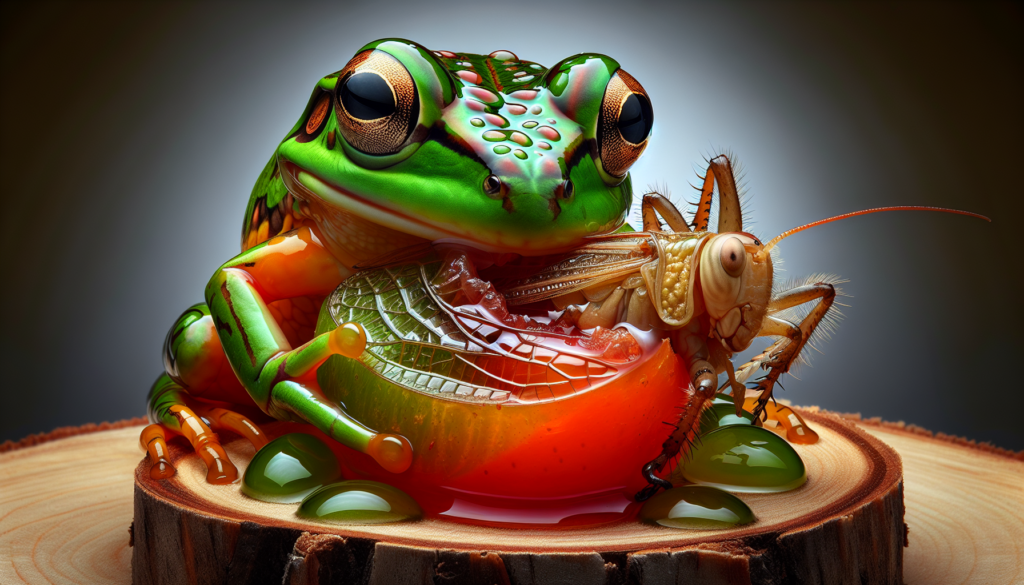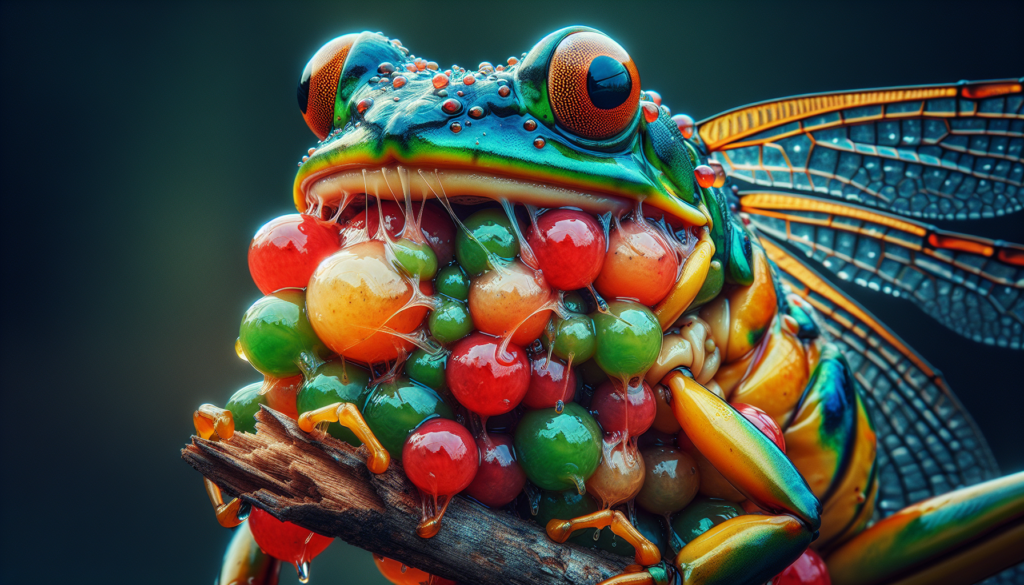Have you ever wondered what sustains those tiny, colorful creatures known as tree frogs? Well, you’re in luck because in this article, we’ll explore the fascinating world of tree frog cuisine. From a wide variety of insects to juicy spiders and crunchy beetles, tree frogs have quite the appetite. Don’t worry, we’ll reveal some surprising delicacies that may leave you in awe. So, get ready to discover the intriguing dietary habits of these remarkable amphibians and find out just what makes their meals as enchanting as they are.
Diet of Tree Frogs

Overview of Tree Frog Diet
When it comes to the diet of tree frogs, these amphibians are known for their diverse and adaptable feeding habits. Tree frogs are omnivorous, meaning they consume both plants and animals as part of their diet. This flexibility allows them to take advantage of a wide range of food sources, making them successful and resilient in various environments.
Types of Food Consumed
Tree frogs have a varied and extensive diet, consisting of both invertebrates and small vertebrates. In terms of invertebrates, they feed on insects such as flies, mosquitoes, grasshoppers, and beetles. They also consume spiders and crustaceans like crabs and shrimp. When it comes to small vertebrates, tree frogs have been known to eat small fish, amphibian tadpoles, and even other tree frog eggs.
However, tree frogs do not solely rely on animal protein. They also incorporate plant matter into their diet. They consume fruits, flowers, and nectar, which provide them with essential nutrients and energy. This omnivorous behavior allows tree frogs to exploit different ecological niches and effectively utilize available resources.
Role of Environment in Diet
The environment plays a crucial role in determining the diet of tree frogs. The availability of food sources in their habitat heavily influences what they eat. Different species of tree frogs live in various regions with distinct ecosystems, resulting in variations in their diets. In areas abundant in specific prey items, tree frogs may specialize in consuming them.
Seasonal fluctuations also affect the diet of tree frogs. As the availability of certain food sources changes throughout the year, tree frogs must adapt their feeding behaviors accordingly. For example, during warmer months, there might be an increase in insect populations, leading tree frogs to consume more insects during this period.
Habitat diversity also impacts the diet of tree frogs. Different habitats provide varying food sources, presenting tree frogs with a range of options. Some species of tree frogs may inhabit forested areas where they have access to a wide array of insects and invertebrates. Others may dwell near bodies of water, allowing them to feed on aquatic prey such as small fish and tadpoles.
Variations in Diet Among Different Tree Frog Species
Tree frogs exhibit variations in their diets, depending on their species. While some species are generalist feeders, consuming a wide range of prey items, others have specialized dietary preferences.
Frog-eating tree frogs, as their name suggests, predominantly feed on other frogs. They possess unique adaptations, such as a larger mouth and strong jaws, which enable them to capture and consume their frog prey effectively.
There are also termite-eating tree frogs that have evolved to specialize in consuming termites. These tree frogs have specific behaviors and physiological adaptations that aid them in locating and consuming their preferred food source. They may use their long tongues to capture individual termites or even engage in cooperative foraging strategies to access termite colonies.
Another group of tree frogs specializes in eating ants. Ant-eating tree frogs have specialized mouths that allow them to exploit ants as a food source effectively. They have adaptations like sticky tongues or grooves on their jaws that aid in capturing and consuming ants.
On the other hand, some tree frogs have a preference for fruits and have been observed feeding on a variety of fruits found in their habitat. These fruit-eating tree frogs play a crucial role in dispersing the seeds of various plant species, contributing to the ecosystem’s biodiversity.

Factors Influencing Food Selection
Several factors influence the food selection of tree frogs. One of the primary factors is the size and morphology of the tree frog itself. Larger tree frog species may have a broader diet range, allowing them to consume a wider variety of prey items. Additionally, the morphology of their mouths and tongues can dictate the kind of food they can capture and consume efficiently.
Hunting techniques also play a role in food selection. Tree frogs employ different strategies to catch their prey, whether it’s through visual or auditory predation. Some tree frogs rely on their excellent vision to spot insects or other small prey items, while others use their acute hearing to detect the movements or sounds made by their prey.
Prey availability in the environment is another critical factor. Tree frogs are opportunistic feeders, meaning they will consume what is readily available to them. If certain prey items are abundant in their surroundings, tree frogs are more likely to incorporate them into their diet.
Specialized adaptations in certain tree frog species can also influence their food selection. For example, specific tree frog species have evolved adhesive toe pads that allow them to catch and consume prey items that live on leaves or other surfaces.
Importance of Diet in Tree Frog Health and Survival
A balanced diet is essential for the health and survival of tree frogs. As with any organism, tree frogs have specific nutritional requirements that must be met to maintain optimal health. Adequate intake of proteins, vitamins, and minerals is crucial for their growth, reproduction, and overall well-being.
Imbalances in diet can have adverse effects on tree frog health. For example, a diet lacking in essential nutrients may lead to malnutrition and weakened immune systems, making tree frogs more susceptible to diseases and infections. Conversely, an excessive intake of certain prey items can also be harmful, as some insects or invertebrates may contain toxins or chemicals that could be detrimental to their health.
The diet of tree frogs also plays a role in their growth and reproduction. A varied and nutritious diet ensures proper development and growth in tree frog tadpoles, enabling them to transform into healthy adult frogs. Additionally, a well-balanced diet supports successful reproduction, allowing tree frogs to produce viable offspring and sustain their population.
Interactions with other organisms further emphasize the importance of tree frog diet. Tree frogs form part of various ecological food webs, both as predators and as prey. Their consumption of insects and other invertebrates helps control population sizes, while serving as a food source for larger predators, such as birds or snakes. Therefore, maintaining a healthy diet is not only important for tree frog individuals but also for the overall functioning and balance of ecosystems.
Human impacts can significantly affect the diet of tree frogs. Deforestation and habitat loss deprive tree frogs of their natural food sources and disrupt the delicate balance of their ecosystems. Pollution and contamination of waterways can lead to the decline of prey populations, making it even more challenging for tree frogs to find suitable food sources. Furthermore, the introduction of invasive species can also impact the availability and composition of the tree frog’s diet, as these species may outcompete native prey items or directly prey on tree frogs themselves.
In conclusion, the diet of tree frogs is a fascinating and vital aspect of their ecology. With their omnivorous nature and ability to exploit different food sources, tree frogs have successfully adapted to a variety of environments. Understanding their diet, the factors influencing food selection, and the importance of a balanced diet in their health and survival helps us appreciate the complex interactions and roles that tree frogs play in their ecosystems.

